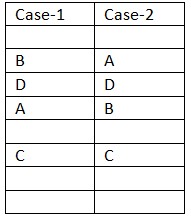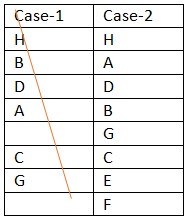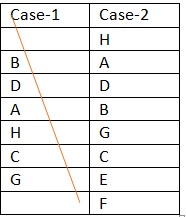Question
Eight boxes namely -A, B, C, D, E, F, G and H are kept
one above another not necessarily in the same order. Box C is kept third from bottom at a gap of two from box D, which is kept adjacent to box B and box A is kept at a gap of one from B. Which box is kept immediate above box E? I. Box G is kept at a gap of two from box A and Box H is neither kept at bottom nor adjacent of C. Box G is kept at a gap of two from box F. II. Box F is kept at a gap of two from box G, which is kept adjacent of box C. Box H is kept immediate neighbor of box A. Each of the questions below consists of a question and two statements numbered I and II given below it. You have to decide whether the data provided in the statements are sufficient to answer the question:Solution
We have: Box C is kept third from bottom at a gap of two from box D, which is kept adjacent to box B that means box D is kept third from top and we have two different case for box B, in case (1) box B is kept immediate above box D and in case (2) box B is kept immediate below box D. Box A is kept at a gap of one from box B, which means in case (1) A is kept immediate below D and in case (2) box A is kept immediately above box D. Based on above given information we get:  From I: We have: Box H is neither kept at bottom nor immediate neighbor of C, which means box H is kept at top. Box G is kept at a gap of two from box A, which means in case (1) G is kept immediate above box C and in case (2) box G is kept immediate above box C. Box G is kept at a gap of two from box F, which means case (1) is not valid and in case (2) box F is kept at bottom. Based on above given information we get final arrangement as follow:
From I: We have: Box H is neither kept at bottom nor immediate neighbor of C, which means box H is kept at top. Box G is kept at a gap of two from box A, which means in case (1) G is kept immediate above box C and in case (2) box G is kept immediate above box C. Box G is kept at a gap of two from box F, which means case (1) is not valid and in case (2) box F is kept at bottom. Based on above given information we get final arrangement as follow:  Thus, box C is kept immediate above box E. Hence, statement I alone is sufficient. From II: We have: Box H is kept immediate neighbor of box A, which means in case (1) box H is kept immediately below box A and in case (2) the box H is kept immediately above box A. Box F is kept at a gap of two from box G, which is kept immediate neighbor of box C, that means case (1) is not valid and in case (2) box G is kept immediate above box C. Based on above given information we get final arrangement as follow:
Thus, box C is kept immediate above box E. Hence, statement I alone is sufficient. From II: We have: Box H is kept immediate neighbor of box A, which means in case (1) box H is kept immediately below box A and in case (2) the box H is kept immediately above box A. Box F is kept at a gap of two from box G, which is kept immediate neighbor of box C, that means case (1) is not valid and in case (2) box G is kept immediate above box C. Based on above given information we get final arrangement as follow:  Thus, box C is kept immediate above box E. Hence, statement II alone is sufficient.
Thus, box C is kept immediate above box E. Hence, statement II alone is sufficient.
What is India’s rank globally in Aluminium production?
How many types of the amendment are mentioned by the Indian Constitution as per Article 368?
What was the fate of Bahadur Shah Zafar, the last Mughal Emperor, after the revolt was suppressed?
How many days are organized for the modern Olympic Games?
In honour of an Indian musician, the US state of Massachusetts proclaimed 20 April as __________ in 1984.
Under which article was the Right of Children to Free and Compulsory Education (RTE) Act, 2009, introduced to provide every child with the right to full...
Sanchar Saathi portal is an initiative, which aims to enhance the ________________?
Sarus Crane, recently seen in the news, is the official bird of which state?
Approximately how much percentage (nearest to integer) of total water on the surface of earth is accounted for by the oceans?
Who is the winner declared when the weightlifting competition is tie?



